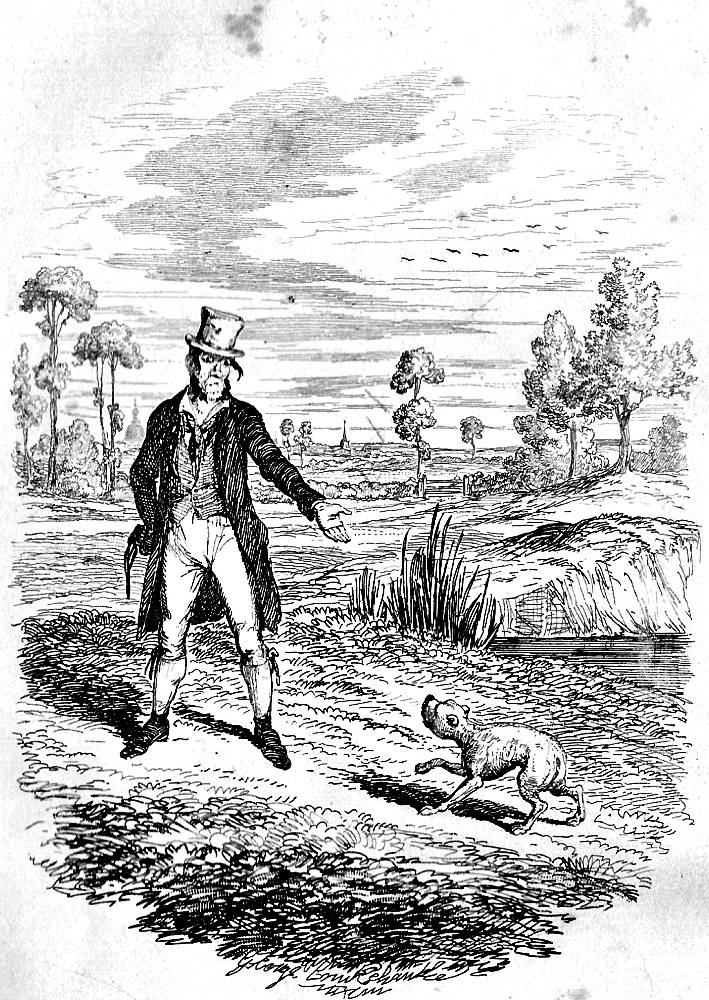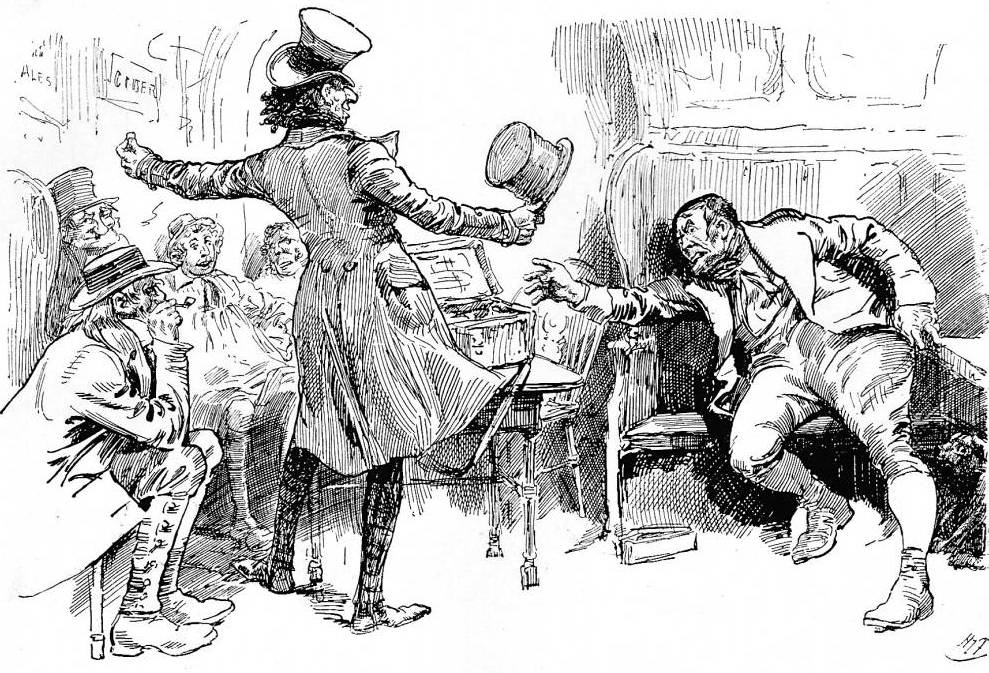
"He moved, backwards, towards the door: dragging the dog with him. — James Mahoney's wholly original illustration of Bill Sikes dragging his dog, Bull'seye, out of the room where the enraged housebreaker has just murdered Nancy, following Fagin's discovery of her appointment with Mr. Brownlow and Rose Maylie on the water-stairs of New London Bridge, overheard by Noah Claypole, as depicted by George Cruikshank in Bentley's Miscellany in The Meeting. The original illustrator does not depict Nancy's murder, for that would undoubtedly have been regarded as far too gruesome a scene for family reading, but does show the deed's effects on the killer in Sikes attempting to destroy his dog (January 1839) and The Last Chance (February 1839), both illustrations already having appeared in the final volume of Richard Bentley's triple-decker in November 1838. The readers of theHousehold Edition find an illustration that anticipates both the murder and its aftermath, in Chapter 47, "Fatal Consequences," before the quarrel between the common-law spouses even begins in The Adventures of Oliver Twist; or, The Parish Boy's Progress. The Mahoney illustration of a passage in Chapter 48 describing Nancy's body bleeding profusely from the face occurs on page 177, just the page before the textual passage in Chapter 47. 1871. Wood engraving by the Dalziels, 9.4 cm high by 13.6 cm wide.
Scanned image and text by Philip V. Allingham. [You may use this image without prior permission for any scholarly or educational purpose as long as you (1) credit the person who scanned the image and (2) link your document to this URL in a web document or cite the Victorian Web in a print one.]
Passage Illustrated
He struck a light, kindled a fire, and thrust the club [which he had employed in bludgeoning Nancy] into it. There was hair upon the end, which blazed and shrunk into a light cinder, and, caught by the air, whirled up the chimney. Even that frightened him, sturdy as he was; but he held the weapon till it broke, and then piled it on the coals to burn away, and smoulder into ashes. He washed himself, and rubbed his clothes; there were spots that would not be removed, but he cut the pieces out, and burnt them. How those stains were dispersed about the room! The very feet of the dog were bloody.
All this time he had, never once, turned his back upon the corpse; no, not for a moment. Such preparations completed, he moved, backward, towards the door: dragging the dog with him, lest he should soil his feet anew and carry out new evidence of the crime into the streets. He shut the door softly, locked it, took the key, and left the house.
[Chapter 48, "The Flight of Sikes," p. 179]
Commentary
Whereas Harry Furniss in his 1910 lithograph offers a dark plate of the scene made famous by Dickens's thrilling reading of it in Britain and America, with only the hands of Sikes and Nancy clearly visible in the terrible darkness as the murder is occurring, the 1870s Household Edition illustrator James Mahoney builds up a very different sort of suspense by focussing not on the grisly deed but on its immediate consequences. Accepting the inevitability of Nancy's death as soon as they encounter the illustration, situated in Chapter 47, readers likely would wonder how Sikes will elude detection, and whether authorities will recognise that Sikes committed the murder at Fagin's instigation. In He moved, backwards, towards the door: dragging the dog with him, Mahoney leaves the reader to imagine the violent scene that has resulted in the contorted body lying on the floor.He does not even permit more than glimpse of the "ghastly figure" (179) as he moves the dog away from "the pool of gore" surrounding the lifeless head. Mahoney illuminates the grotesque scene by natural light, throwing Nancy's head and arms into glaring chiaroscuro, intensifying the deep shadows, and drawing the viewer's eye diagonally upward to the left and the retreating Sikes, and to the overturned potted plant on the window-ledge (right), suggestive of the violence of the struggle just ended, and perhaps erven a symbol of a young woman cut down in her prime. A telling detail derived directly from the text is "paper-mended window" (179) that implies the low quarters that the couple have been living in since the robbery. The illustrator, however, shows the body from the waist up, whereas Sikes has apparently covered the entire corpse with a rug. Mahoney deemed it important that Nancy be recognisable.
Illustrations from the original serial (1838), Diamond Edition (1867), and Charles Dickens Library Edition (1910)



Left: George Cruikshank's "Sikes attempting to destroy his dog" (1839). Centre: Sol Eytinge, Junior's "Bill Sikes and Nancy" (1867). Right: Harry Furniss's Charles Dickens Library Editionillustration "The Death of Nancy" (1910). [Click on images to enlarge them.]
References
Bentley, Nicolas, Michael Slater, and Nina Burgis. The Dickens Index. New York and Oxford: Oxford U. P., 1990.
Cohen, Jane Rabb. "George Cruikshank." Charles Dickens and His Original Illustrators. Columbus: Ohio State U. P., 1980. Pp. 15-38.
Darley, Felix Octavius Carr. Character Sketches from Dickens. Philadelphia: Porter and Coates, 1888.
Davis, Paul. Charles Dickens A to Z: The Essential Reference to His Life and Work. New York: Facts On File, 1998.
Dickens, Charles. The Letters of Charles Dickens. Ed. Graham Storey, Kathleen Tillotson, and Angus Eassone. The Pilgrim Edition. Oxford: Clarendon, 1965. Vol. 1 (1820-1839).
Dickens, Charles. Oliver Twist. Illustrated by George Cruikshank. London: Bradbury and Evans; Chapman and Hall, 1846.
Dickens, Charles. Oliver Twist. Works of Charles Dickens. Household Edition. 55 vols. Il. F. O. C. Darley and John Gilbert. New York: Sheldon and Co., 1865.
Dickens, Charles. Oliver Twist. Works of Charles Dickens. Diamond Edition. 18 vols. Illustrated by Sol Eytinge, Jr. Boston: Ticknor and Fields, 1867.
Dickens, Charles. The Adventures of Oliver Twist. Works of Charles Dickens. Household Edition. Illustrated by James Mahoney. London: Chapman and Hall, 1871.
Dickens, Charles. Oliver Twist. Works of Charles Dickens. Charles Dickens Library Edition. Illustrated by Harry Furniss. London: Educational Book Company, 1910.
Last modified 23 December 2014